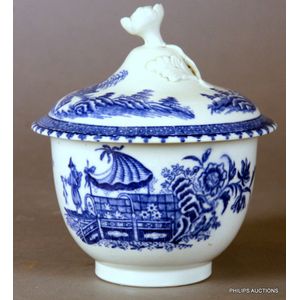Meissen Onion Pattern Tureen with Acanthus Handles
You must be a subscriber, and be logged in to view price and dealer details.
Subscribe Now to view actual auction price for this item
When you subscribe, you have the option of setting the currency in which to display prices to $Au, $US, $NZ or Stg.
- Finial - An architectural decoration, found on the upper parts of of an object. On furniture they are usually found on pediments, canopies and shelf supports. On smaller ceramic or silver items, such as spoons, they may decorate the top of the item itself, or the lid or cover where they provide a useful handle for removal.
Finials have a variety of shapes and forms. They may be urn-shaped, baluster shaped round or spiral, but usually taper into an upper point. Many real life shapes may also be used as finials, such as pineapples, berries, pinecones, buds, lotus and acorns. Sometimes animals such as a lion are depicted, or fish and dolphins. - Onion Pattern - The onion pattern is a popular design motif used in the decoration of porcelain, especially in European and Chinese porcelain. It typically consists of a central motif, such as a flower or bird, surrounded by concentric circles of leaves, flowers, and other decorative elements. The onion pattern originated in China during the Ming dynasty (1368-1644) and was later adapted by European porcelain makers in the 18th century, by companies such as Meissen, Royal Copenhagen and Hutschenreuther, and in England by manufacturers such as Royal Wedgwood, Crown Derby and Spode. The name "onion pattern" is thought to have originated from the shape of the central motif, which resembles an onion or a pomegranate. The pattern is often executed in underglaze blue, but it can also be found in other colours such as red, green, and gold.
- Acanthus - A stylized leaf motif, one of the primary decorative elements of classical Greek and Roman architecture, derived from the genus of flowering plants in the family Acanthaceae, native to tropical and subtropical regions of the Mediterranean area. It is a common element in classical Greek and Roman design, and is often seen in Corinthian and Composite order columns and used as a decorative element in English, European and Australian furniture, particularly on the curve of a leg, and as decoration for a corbel.
This item has been included into following indexes:
Visually similar items

A first period Worcester blue and white sugar bowl and cover, circa 1760s, unmarked or partial mark only, the deep bowl with a shaped domed cover with a projecting lip and an applied floral finial and leaves, decorated with the traditional fisherman and Co

Herend lidded jar #6095, with oriental decoration and dolphin finial, 16 cm high approx.

Wedgwood blue and white 'Real Homes of Britain' impressive lidded tureen

Large Royal Worcester squat pot pouri lidded jar blush ivory decorated with floral sprigs. Lid restored
